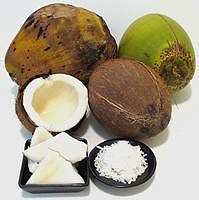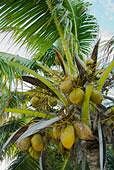Tiki Central / Tiki Drinks and Food
History of the Coconut
Pages: 1 9 replies
|
V
VampiressRN
Posted
posted
on
Sun, Apr 13, 2008 1:46 PM
I have always been intrigued by the coconut, it is a bizarre yet versatile fruit, so here is a little info.
HISTORY OF THE COCONUT On the Nicobar Islands of the Indian Ocean, whole coconuts were used as currency for the purchase of goods until the early part of the twentieth century. Coconuts are the fruit of the coconut palm, botanically known as cocos nucifera, with nucifera meaning "nut-bearing." The fruit-bearing palms are native to Malaysia, Polynesia and southern Asia, and are now also prolific in South America, India, the Pacific Islands, Hawaii and Florida. The light, fibrous husk allowed it to easily drift on the oceans to other areas to propagate. In Sanskrit, the coconut palm is known as kalpa vriksha, meaning "tree which gives all that is necessary for living," because nearly all parts of the tree can be used in some manner or another. The coconut fruit has many food uses for its water, milk, meat, sugar, and oil. It also functions as its own dish and cup. The husk was burned for fuel by natives, but today a seed fibre called coir is taken from the husk and used to make brushes, mats, fishnets, and rope. A very potent fermented toddy or drink is also made from the coconut palm's sap. Coconut oil, a saturated fat made from dried coconut meat, is used for commercial frying and in candies and margarines, as well as in non-edible products such as soaps and cosmetics. Although it takes up to a year for coconuts to mature, the trees bloom up to thirteen times a year. Fruit is constantly forming, thus yielding a continuous harvest year-round. An average harvest from one tree runs about 60 coconuts, with some trees yielding three times that amount. The coconut's name is a bit of a misnomer, since it is botanically classified as a drupe and not a nut. It is the largest seed known. COCONUT STORAGE & SELECTION Fresh unopened coconuts can be stored at room temperature for up to four months, depending on its original freshness when purchased. Grated fresh coconut should be put in a tightly sealed container or plastic bag and stored in the refrigerator for up to four days or frozen for up to six months. Unopened canned coconut can be stored at room temperature for up to eighteen months. Packaged coconut in plastic bags can be stored up to six months at room temperature. Once opened, canned and packaged coconut should be refrigerated and used quickly, within 5 to 7 days for canned and within 3 to 4 weeks for dried. The high oil content makes coconut quickly turn rancid if not stored under the proper conditions. One medium-sized fresh coconut will yield 3 to 4 cups grated or flaked coconut and 1 cup of liquid. Do not pack tightly when measuring grated or flaked coconut. If shredded coconut becomes dry, soak it in milk for 30 minutes, then drain off the milk and pat dry with paper towels. You can use the drained milk in recipes or blended drinks within 5 days. COCONUT FORMS & AVAILABILITY If you do not have access to fresh coconut, you can find dried, desiccated, grated, flaked or toasted coconut in packages or cans, usually in the area where cake-baking supplies are sold or sometimes in with the canned fruits. Shredded coconut has less than 3 percent moisture content and about 68 percent oil. It is also sold frozen in the freezer cases as well as in both sweetened and unsweetened forms. You can toast or color your own at home. If you are lucky enough to have a coconut palm, you can also enjoy green coconuts. COCONUT LORE & LEGEND In northern India, it is the fruit of the "Tree of Life," where coconuts are kept by priests to dispense as a fertility symbol to women who wish to conceive. On the other hand, in Bali, women are forbidden to touch coconut palms for fear of draining the fertility of the tree into the woman. In New Guinea, it is believed that the palm sprouted from the head of the first man to die. On some South Pacific Islands, discs were carved from the hard shell to be used as currency. COCONUT MILK However, the coconut water is consumed as a drink fresh from the coconut by many, and it can also be used in recipes. Coconut milk is actually a combination of equal parts of shredded coconut and water, simmered and then strained through cheesecloth, squeezing out as much of the essence of the pulp as possible. You can find canned coconut milk and cream in most markets along with canned fruit juices or try your hand at making your own. Do not confuse sweetened "cream of coconut" (used for desserts and mixed drinks) with unsweetened coconut milk or cream.
GROWING COCONUT PALMS There are several varieties planted but the old 'Jamaica Tall' coconuts have almost all died of Lethal Yellowing disease. This previously dominant variety is the very tall, curving type. Their is a shorter, fatter Green Malayan Coconut produces green nuts and a less popular Golden Malayan which sports yellow nuts and somewhat yellow fronds. There is also a Red Malayan species. These are rated at 95% resistant to Lethal Yellowing. The taller growing Maypan Coconut is harder to acquire but is similar to the stately Jamaicans of the times before Lethal Yellowing took its toll. A new type is the 'Red Spicata Dwarf' cultivar. Slower growing than the Maypan, it is actually a semi-dwarf plant, and shorter than "Malayan Dwarf' variety. It has a more delicate appearance and orange-red fruit. It is being tested for disease resistance to Lethal Yellowing. Another new coconut is the 'Fiji Dwarf' and is another shorter palm. It has a crown of leaflets that are very wide and produce a dense shade. It is a true dwarf, slow growing and will be relatively small at maturity. The most rare variety is the Double Coconut, Lodoicoa maldivica, whose fruit size is more like 5x a normal Coconut. Coconuts are salt tolerant growing right on the beach, but do better a few hundred feet back. For best results, acquire a small young coconut and plant it with plenty of high quality manure (50 lbs. is good) mixed in the planting hole and soil. Fertilize 4x to 6x a year with top quality palm food and watch your coconut grow to its maximum beauty. If you plant young trees and care for them well, they get extra fat and grow even more beautiful. Many think of all coconut palms as growing all over Florida, but the coconut is a tropical which will eventually freeze north of approx. West Palm Beach on the east coast and approx. north of Fort Myers on the west coast of Florida. Coconut palm can grow outside those "boundaries" but eventually a freeze will kill. For example, there once were an estimated 25,000 coconut palms growing happily in Vero Beach ...all those "originals" died within 4 hours one freezing night SPROUTING PALM SEEDS To start a coconut from the seed, you want a freshly fallen brown-dry (somewhat shrunken) nut with the outer fibrous husk intact. Get a 3-gallon pot. Use high quality nursery soil mixed with 40% coarse sand. Add drainage rocks to the bottom of the pot. Lay your coconut husk on the ground and see which way it wants to rest. Plant your coconut husk 1/2 way into the soil in the same position. You can leave the pot in the sun or the shade. Water lightly to keep very lightly moist. Partial shade will likely be more successful. Be patient, it can take 9 nine months to sprout. It is common for many palms to take many months to sprout. Don't over water as you'll rot them out. A coconut often will first split its husk at the bottom and send down some roots. It may take several months before your coconut also splits the top of the husk pushing up its first fronds. Every one is a little different. Your nut may split the top first. After your coconut spouts, your coconut can live in your 3-gallon pot for about 3-6 months. After that, plant it in another larger pot or directly into the soil. Incorporate lots of manure. Fertilize properly starting after sprouting 3 fronds. |
|
P
pablus
Posted
posted
on
Sun, Apr 13, 2008 4:48 PM
Make sure to give your coconut palm epsom salts - a small handful every 6 months. Hoping all your fronds are green, |
|
TG
The Gnomon
Posted
posted
on
Mon, Apr 14, 2008 10:18 AM
It is difficult to imagine anything Tiki without the coconut palm. Here is another link to horticultural info. |
|
UB
Unga Bunga
Posted
posted
on
Mon, Apr 14, 2008 12:59 PM
[ Edited by: Unga Bunga 2008-04-14 13:01 ] |
|
LFT
Little fragrant Tiare
Posted
posted
on
Mon, Apr 14, 2008 1:11 PM
Thanks for all these links! i love the coconut.. I`m having a drink now in a scooped out honeydew melon filled with crushed ice, rum and cold coconut water with a sprig of mint for garnish. Cheers! |
|
N
naugatiki
Posted
posted
on
Mon, Apr 14, 2008 3:43 PM
What I find strange about coconuts is it's one food that polarizes people where they either love it or it turns their stomach. I can't tell you how many chi chis I've had to drink after a guest takes a sip and hands the drink back to me, not that I'm complaining. |
|
C
cheekytiki
Posted
posted
on
Tue, Apr 15, 2008 12:11 AM
Great info, the bit that I like best is where the name comes from, I never knew that. It is especially funny when one of my clients opened an ultra exclusive bar and club this winter in Switzerland and it's name translates as " Monkey Face"! |
|
TG
The Gnomon
Posted
posted
on
Wed, Apr 16, 2008 5:57 AM
Mmmmmm! Coconut milk. My favorite. |
|
V
VampiressRN
Posted
posted
on
Sat, Jun 14, 2008 11:10 AM
I found this interesting little piece of information on the myth of the Coconut Tree..... Tuna, the eel lover of Sina, was killed by jealous suitors, but at his last meeting he had told Sina of his impending fate. He commanded her to cut off his head after he was slain and to plant it. From his head would grow a tree with a fruit that would furnish her with both meat and drink. On the fruit itself she would see the two eyes that had adored her and the mouth that had spoken tender words of love. So it came to pass that Sina planted the head of Tuna and from it grew the coconut palm. The myth is found throughout Polynesia, and outside of Samoa the dialectical form of Hina replaces Sina. Even now, the Polynesian who husks a drinking nut for a stranger, delights to point out the eyes and mouth of Tuna represented by three depressions on the top of the shell. The mouth depression is the only one that pierces the full thickness of the shell, and it is closed with soft material. It is through the mouth of Tuna that the shoot passes to the outside of the nut to grow into a tree to provide food and drink for the descendants of Sina. |
|
M
Murph
Posted
posted
on
Sat, Jun 14, 2008 8:28 PM
That's cool... thanks |
Pages: 1 9 replies



